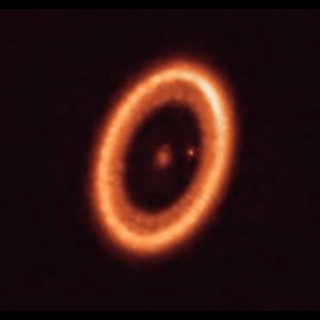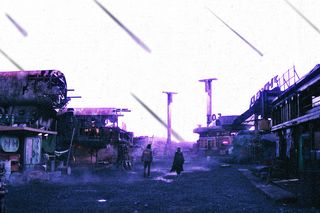
Can Apocalyptic Sci‑Fi Movies About Climate Change Serve As a Tool for Climate Activism?
The invisibility of climate change is best countered through cinema that allows people to “see” the impact of environmental devastation.

The Climate Disaster of 2048, the eruption of the Krakatoa in 2049, the Extinction of the Swallow in 2050, the Tsunami of 2051.
It is a disquieting laundry list — of famines, cyclones, volcanic eruptions, and more. Events dated well into the future, but may as well be from this decade — even now. They figure in Marvel’s television series “Loki,” which positions climate change front and center in one of its episodes. In a conversation, a character, Mobius, particularly notes how badly we, humans, have messed up the ecosystem. The verdict is damning: It’s “just one damn thing after another.”
“Loki” (2021) is a work of fiction. As are other science-fiction movies and shows loyally holding on to the climate catastrophe plot point. Although they make for an uncomfortable watch, these on-screen apocalypses have become an increasingly popular part of recent narratives. Depictions are becoming more realistic in how they show climate crisis (as something that is gradual and pernicious); plots are nuanced in showing the socio-cultural inequalities; they establish the cause and effect of human activity to extinction or climate disasters with profound clarity.
The clincher is, perhaps, that reel and real are now interchangeable. Climate crisis has existed at a distance, something that belongs far away, in time and distance. Pop culture comes with a prescient foresight, allowing us to see a grim future: one of ferocious storms, higher temperatures, droughts, fires, floods, extreme weather of all sorts — in India and beyond — endangering people and ecosystems, will look like.
***
“Climate change is of such a vast, abstract, and immense geographic and chronological scale that it remains wholly remote from most people’s day-to-day experience, even when living through direct manifestations of it,” researchers Theodore Jacob Vincent and James F. Hamilton noted in a paper. They concluded that a cultural understanding, aided by popular culture, is critical to making the crisis feel more personal.
Why rely on the fictive format, one that dilutes fact with fiction? “Story is one of the oldest and most powerful forms of communication we ever had. When someone says ‘now, let me tell you a story …’ something goes ‘zzzzzt’ in your brain. It’s like when you were a child and your parent says they are going to tell you a bedtime story. It automatically opens you up, ” Anthony Leiserowitz, a senior research scientist at the Yale University School of Forestry & Environmental Studies and director of the Yale Program on Climate Change Communication, told CNN.
“Film, so far,” Anthony Leiserowitz says, “is the most powerful form of storytelling that we’ve devised.”
This eco-fiction at once foreshadows, and relays, today’s calamities. They say naming a problem is the first step to confronting it — showing it seems to be the next natural step.
Related on The Swaddle:
What Makes Doomsday Preppers Brace For The Apocalypse?
Further, the language of climate science is too academic and inaccessible for most; it often doesn’t do justice to the urgent and intense crises we face. Books, research papers, statements by scientists and experts simply do not have the same impact and get written off as alarmist. Research is hard to gauge owing to the complexities and scientific nuances. The jargon drowns out the desperation.
This communication is effective because it puts things in perspective. It reframes “the perspective from a detached and scientifically-articulated problem to one of a human condition – immediate and personal,” Ailise Bulfin wrote in a paper. Striking popular culture images of burnt landscapes, tidal waves, and ice-bound cities have the potential to emotively convey the dangers of climate change.
A 2020 paper notes: “Meaningful visualization of environmental issues… [helps] bridge the gap between issues of complex science and people’s daily experiences, thereby simplifying issues.”
Thus, pop culture representation becomes what Marina Hassapopoulou, assistant professor of Cinema Studies at New York University, calls “eco-critical.”
“There is no longer a clear distinction between science and fiction, and this is what makes the on-screen environmental issues feel less speculative and more real to audiences,” she tells me. The environmental collapse these movies describe isn’t far from where we are today. A writer in BBC Future echoed this sentiment as follows: “’Blade Runner’ is no longer science fiction. It’s a contemporary thriller.”
Fiction, Hassapopoulou notes, seems to be mimicking reality more so in recent years. She cites the Greek island-set “Blind Sun” (2015) that depicts a country struggling with an ongoing heatwave and subsequent water shortage, all against the backdrop of the refugee crisis. “This film demands an active and critically reactive viewer to decipher its complex and multi-layered message regarding the connections between climate change and other human-made disasters such as systemic violence and racial/ethnic discrimination.”
Replace the ongoing heatwave in the film with a pandemic scenario; countries like Sudan and Syria teeming with refugees face a water and hunger crisis of epic proportions, worsened in the face of Covid19.
These portrayals also offer a commentary on social inequities and consumerism. A scene from “Loki” unfolds like this: it is the fall of civilization, a hurricane is set to wreak havoc in Alabama in 2048; the night before, you find people taking shelter in a grocery store, simultaneously purchasing things for sale.
Another depiction in the episode: on an unnamed planet on the cusp of destruction due to climate change, a Noah’s Ark of sorts is preparing to take passengers to safety. A woman sits quietly in her hut, far away from the action. When asked why she isn’t rushing to the Ark, she notes plainly that she can’t afford a ticket. Damaging the environment is a luxury; so is escaping a climate crisis. Such explorations of climate change, though filtered through fictional plots, are in essence presented through the viewers’ experiences.
The inquiry resonates in a world where the disproportionate impact of ecosystem damage is gravely felt. Communities most vulnerable to displacement due to climate change are the ones least responsible for it. The scale of inequality has already tipped against them — close to 1.5 million people from disadvantaged communities are internally displaced in India every year mostly due to climate change; the number is much higher globally. Africa, one of the most vulnerable regions to climate change, curiously accounts for the lowest greenhouse gas emissions in the world.
The imperative of “future,” experts have noted, remains the primary obstacle in selling climate change as an impending reality; but visuals showing climate crisis across four continents in one day strip off that belief.Bryan Doerries summarizes the the stakes as follows:“A virulent pandemic has taken the lives of three million people. The Earth is in the throes of a sixth mass extinction. And the problems are set to escalate.”
These instances correlate climate change we see today makes the specter damning in its potential — that it can damage on-screen and off-screen. With cinematic portrayals, the climate crisis is no longer “unthinkable.”
***
Related on The Swaddle:
Deadly Heatwaves Will Be the Norm in India by 2040: Report
Watching a world on fire — a world that looks very much like our own — on-screen may work to influence specific individual behavior. “Recent sci-fi that focuses on environmental issues demands active viewers/readers, and aims to cultivate individual critical thinking regarding ongoing ecological issues (as well as other issues that either cause or arise from ecological crises),” Hassapopoulou says.
“Some sci-fi fiction even goes as far as to provide calls for action, using the genre to raise awareness rather than merely entertain.” Arguably, cinematic science fiction offers ways to engage with a grim outlook of the future.
In 2019, two researchers looked at theorist Stern’s “Value-Belief Norm Theory” of environmentalism, which had the following hypothesis: visualizing adverse effects from global warming could promote mitigation behavior. By mapping how persuasive climate fiction movies are, they observed how narrative engagement and explicit references to human responsibility influence behavior. They zoomed in on two indirect effects: the film increased a sense of personal obligation to act, and engaging with the narrative increased a sense of guilt.
A 2018 survey in the U.S. took public opinion a week before a scientific fiction movie’s release — and four weeks later. “Across the board, the movie appears to have had a strong influence on watchers’ risk perceptions of global warming,” the researchers concluded.
They add: “Most moviegoers didn’t worry that the most extreme scenario, like what happened in the movie, would happen in real life, but those who saw it, compared with those who skipped, felt more inclined to make personal changes to reduce their carbon footprint. They were more inclined to talk to friends about climate change, and seeing the film affected voter preferences.”
Which is not to say all climate fiction is a work of benevolence. The formula sometimes used in portraying environmental issues may not always be sound: some stories are padded with dramatic plotlines, the catastrophe befalls abruptly. The hero/heroes-ultimately-saving-the-day narrative also does little to reinforce the irreversible and un-savable nature of the climate crisis.
While movies like Danny Boyle’s “Sunshine” (2007) and Christopher Nolan’s “Interstellar” (2014) managed to weave in climate change into the conversation, they were hardly ever believable. Somewhere in those action sequences, chases, and mystery, we as viewers tend to remove ourselves from the thrust of the issue.
But recognizing these missteps helps understand what works — and what doesn’t. These depictions are slight subversions to the science-fiction pocket of cinema, one that has previously allowed for fleeting moments of escapism. But now, it’s hard to escape the inconvenient truth of barren lands, toxic air, dilapidated structures, unprecedented catastrophes.
In the end, the death of a planet remains a curious thing to show. “As climate change becomes more of a concern for more people,” Beth Accamondo noted in KPBS, “films, TV, and science fiction will delve even more into the fears, anxieties, and concerns we have to help us explore the issue.”
“In suggesting the worst that can happen, science fiction can deliver a very potent warning. It can also inspire people to come up with solutions.”
Saumya Kalia is an Associate Editor at The Swaddle. Her journalism and writing explore issues of social justice, digital sub-cultures, media ecosystem, literature, and memory as they cut across socio-cultural periods. You can reach her at @Saumya_Kalia.
Related


Scientists Discover 15,000‑Year‑Old Viruses in Melting Tibetan Glaciers
